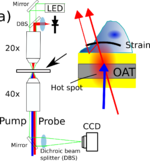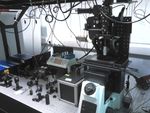Difference between revisions of "Cell Imaging Using Picosecond Ultrasonics"
(→Fixed Cells) |
(→Fixed Cells) |
||
| Line 57: | Line 57: | ||
{|class="wikitable" align="" | {|class="wikitable" align="" | ||
|- | |- | ||
| − | |[[Image:PLU_fixedCell1.png | | + | |[[Image:PLU_fixedCell1.png |300px|alt=alt text|image of cell]] |
| − | |[[Image:PLU_fixedBrillouin1.png | | + | |[[Image:PLU_fixedBrillouin1.png |300px|alt=alt text|Brillouin image of cell]] |
|} | |} | ||
A different fibroblast cell is shown below, here we can see much more detail, with the filopodia clearly visible. | A different fibroblast cell is shown below, here we can see much more detail, with the filopodia clearly visible. | ||
{|class="wikitable" align="" | {|class="wikitable" align="" | ||
|- | |- | ||
| − | |[[Image:PLU_fixedCell2.png | | + | |[[Image:PLU_fixedCell2.png |300px|alt=alt text|image of cell]] |
| − | |[[Image:PLU_fixedBrillouin2.png | | + | |[[Image:PLU_fixedBrillouin2.png |300px|alt=alt text|Brillouin image of cell]] |
|} | |} | ||
The image below shows a scan of a fixed cardiac cell, the striations of the cell are clearly visible, these repeating structures are how the cells contract, and have spacings on the order of a few microns. | The image below shows a scan of a fixed cardiac cell, the striations of the cell are clearly visible, these repeating structures are how the cells contract, and have spacings on the order of a few microns. | ||
{|class="wikitable" align="" | {|class="wikitable" align="" | ||
|- | |- | ||
| − | |[[Image:PLU_cardiacOptical.png | | + | |[[Image:PLU_cardiacOptical.png |300px|alt=alt text|image of cell]] |
| − | |[[Image:PLU_cardiacBrill.png | | + | |[[Image:PLU_cardiacBrill.png |300px|alt=alt text|Brillouin image of cardiac cell]] |
|} | |} | ||
Revision as of 10:57, 5 June 2015
Contents
Motivation
Detection mechanism - Brillouin Oscillations
The probe light is reflected from the sample surface to the detector, and if the sample is transparent there is also a reflection from the acoustic wave packet traveling in the sample. This happens because the acoustic wave causes a change in the local refractive index and so acts as a weak mirror. These reflections interfere at the detector and as the phase of the reflection from the acoustic wave is changing with time it leads to an oscillating signal. These oscillations are termed Brillouin Oscillations.
The frequency F of the oscillation is given by the simple equation: F = 2*Va*n/λ
So if we can measure this signal we can measure the acoustic velocity Va, as long as we know the laser wavelength λ and the refractive index n.
Substrate Design
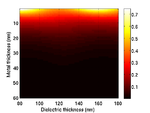 |
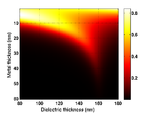
|
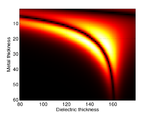 |
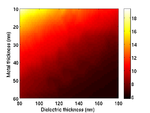
|
The cells are grown on a transducer substrate similar to those described here. The optimization of the transducer layer is different in this case. Here we are much more concerned with optimizing the optical properties of the transducers. The goal is to reduce the amount of blue light reaching the cell and either maximize the reflected or transmitted light, depending on the experiment requirements. We still have to ensure that the acoustic performance of the transducer is correct and that the acoustic bandwidth is sufficient to generate waves in the Brillouin frequency range of the sample.
Instrumentation advancements to enable imaging
Measurements are made using a pump/probe picosecond laser ultrasound instrument utilizing ASOPS lasers. These laser control the delay between the pulse electronically removing the need to mechanically scan a delay line. this allows the very small signals present in these typos of experiments to be obtained quickly.
The pump beam is frequency doubled in a non linear crystal to have a wavelength of 390nm, the probe beam is at 790nm and both beams can be directed to the sample through and objective lens normal to the sample. optionally the pump beam can also be directed to the underside of the sample to generate the acoustic waves from below.
The instrument also has optical paths for wide field phase contrast imaging to allow the cells being studied to be visualized. This allows to assess the cells health and locate the scan region and register the acoustic image with the cell of interest.
The acoustic signals are captured by recording the probe beam power with a photo-diode, this signal is then filtered and amplified before being digitized in a digital oscilloscope. To build up an image the sample is raster scanned.
Ultrasonic images of Cells
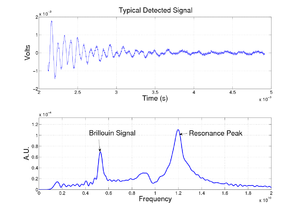
|
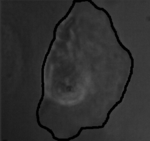 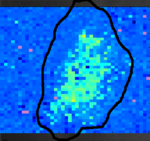
|
An example trace is shown where the Brillouin signal from a cell is shown to be higher than for a plain water sample, the extra peaks present are the resonant frequency of the substrate itself.
Also shown are phase contrast images of the cells on the substrate the cells have very little optical contrast and so a simple bright field microscope is not sufficient to visualize the cells.
The acoustic image has the cell outline applied and you can see that in the centre of the cell the frequency increases. At the edges there is no change from the blue substrate back ground, this is likely due to the fact that the cell is very thin at the edges and so does not produce a Brillouin signal.
Fixed Cells
By recording the Brillouin frequency while scanning the sample images can be taken. The below shows a Brillouin frequency map of a fixed fibroblast cell, this image shows the location of the nucleus (the redder region).
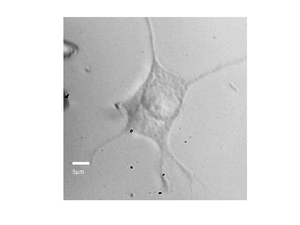
|
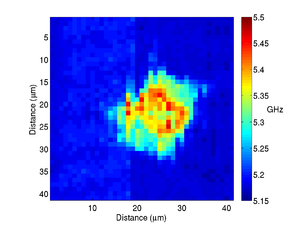
|
A different fibroblast cell is shown below, here we can see much more detail, with the filopodia clearly visible.
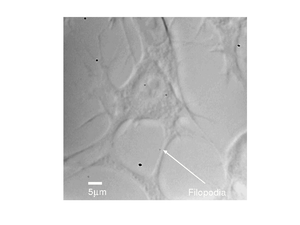
|
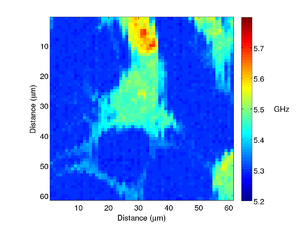
|
The image below shows a scan of a fixed cardiac cell, the striations of the cell are clearly visible, these repeating structures are how the cells contract, and have spacings on the order of a few microns.
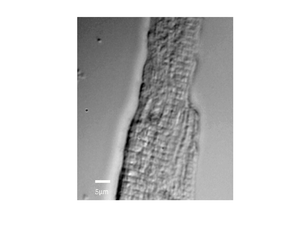
|
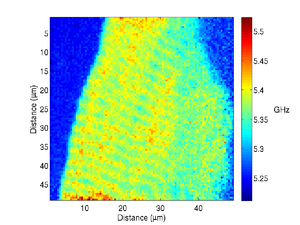
|
Live Cells
3D imaging
Related Publications and Talks
Smith Richard J., Cota Fernando Perez, Marques Leonel, Chen Xuesheng, Arca Ahmet, Webb Kevin, Aylott Jonathon, Somekh Micheal G., Clark Matt - Optically excited nanoscale ultrasonic transducers
- The Journal of the Acoustical Society of America 137:219--227, jan 2015
- http://scitation.aip.org/content/asa/journal/jasa/137/1/10.1121/1.4904487
Bibtex<div>Author : Smith Richard J., Cota Fernando Perez, Marques Leonel, Chen Xuesheng, Arca Ahmet, Webb Kevin, Aylott Jonathon, Somekh Micheal G., Clark Matt
Title : Optically excited nanoscale ultrasonic transducers
In : The Journal of the Acoustical Society of America -
Address :
Date : jan 2015
</div>
Richard Smith, Fernando Perez, LeonelMarques, Matt Clark,Design and application of nano-scaled transducers,Institute of Physics Optics + Ultrasound One Day Meeting, May 2013, Nottingham, UK
Fernando Perez Cota, M. Clark, K. F. Webb, and R.J. Smith, Nanoscale transducers for picosecond laser ultrasonics in cells,3rd symposium of laser ultrasonics, June 2013, Yokohamma, Japan,
